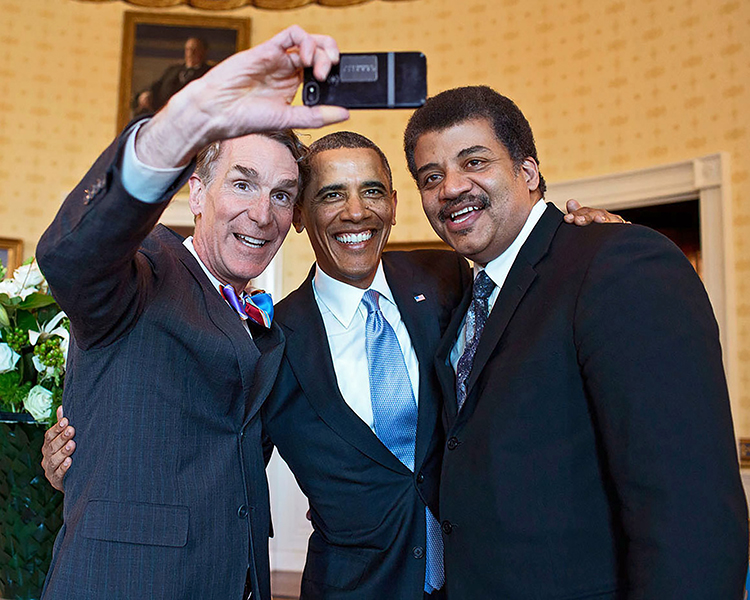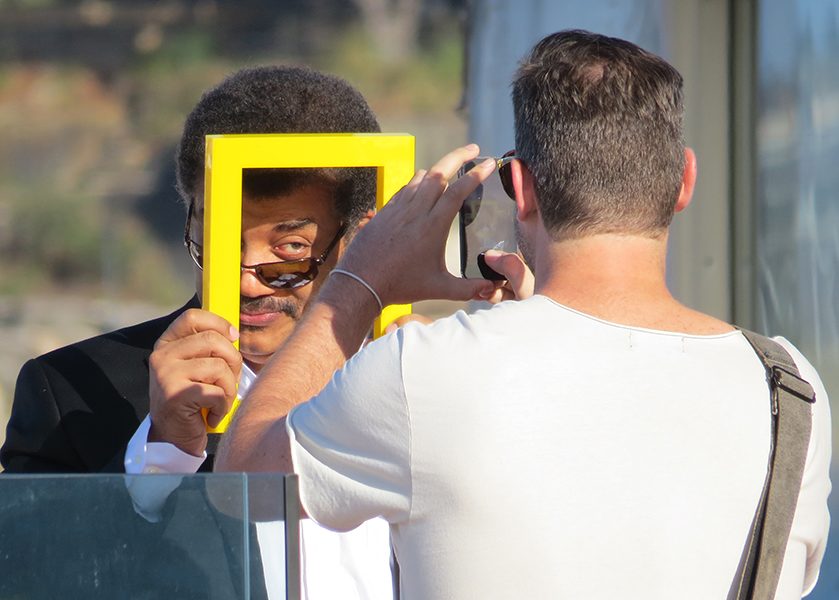No, he didn’t ask a referee or the NFL commissioner.
He went to astrophysicist Neil deGrasse Tyson, the Frederick P. Rose director of the Hayden Planetarium at the American Museum of Natural History in Manhattan.
Tyson responded on Twitter, ruling that the pass was a legitimate “Galilean Transformation,” with the ball moving backward instead of forward, which would’ve been illegal.
Needless to say, the Twitterati had a lot of fun with that one. They’re still not sure what a Galilean Transformation is — neither are we — but score it as a touchdown for Tyson, one of our planet’s go-to guys for all things time-space related.

Indeed, few have done more to popularize the esoteric subject of astrophysics than Tyson — host of the “StarTalk” podcast, featuring stars here on Earth as well as those in the heavens, and author of “Astrophysics for People in a Hurry” (W.W.Norton & Co., $18.95, 222 pages) — the most recent of his 13 books.
As director of the Hayden Planetarium at the Frederick Phineas and Sandra Priest Rose Center for Earth and Space since 1996, Tyson oversaw its $210 million renovation, completed in 2000, and founded its Department of Astrophysics.
Tyson coined the term “Manhattanhenge” for the phenomenon in which the setting sun aligns perfectly with Manhattan’s street grid (on Memorial Day and during baseball’s All-Star break). The popular astronomical bellwether is also not afraid to wade into controversy. Witness Pluto-gate, in which Tyson fought to have Pluto demoted from the formerly nine planets in a reclassification of these heavenly bodies by type.
”Pluto does not have a family except for the icy bodies in the outer solar system,” Tyson told The New York Times in a 2001 article titled “Pluto’s Not a Planet? Only in New York. “So we simply group it with the Kuiper Belt.” It’s gone, he added, ”from puniest planet to king of the Kuiper Belt. And I think it’s happier that way.”
Maybe, but the hate mail poured in — much of it from children, who saw in tiny Pluto a friend being picked on — and Tyson found himself defending the reclassification on “The Colbert Report” and “The Daily Show.” (Pluto-crats can immerse themselves in the saga in Tyson’s “The Pluto Files: The Rise and Fall of America’s Favorite Planet.”)
Last month, Tyson went off on the supermoon — a full moon that is at the portion of its orbit closest to Earth so it looks like the moon in “Moonstruck.”
“FYI: The very concept of a Super Moon is an embarrassment to everything else we call super: Supernova, Supercollider, Superman, Super Mario Bros,” he tweeted. “If (November’s) Full Moon were a 16.0 inch pizza, then (December’s) ‘Super’ Moon would be 16.1 inches. I’m just saying.”
So, in other words, if “the moon hits your eye like a big pizza pie,” as in the Dean Martin hit (and “Moonstruck” motif ) “That’s Amore,” feel free to go “meh.”
Behind such amusing provocations is clearly a real passion for promoting the principles of astronomy.
“…When I was a kid…there were scientists and educators on the staff of the Hayden Planetarium…who invested their time and energy in my enlightenment,” he wrote in his memoir “The Sky Is Not the Limit: Adventures of an Urban Astrophysicist.” “I feel this deep sense of duty, that I serve in the same capacity for people who come through the facility today that others served for me.”
It was at the Hayden Planetarium that this native New Yorker’s love of the stars was born. The son of a gerontologist of Puerto Rican descent and an African-American sociologist, Tyson remembers being enrapt by the night sky in the planetarium’s star theater. It was, he has said, the universe calling him.

Heeding that call, he attended The Bronx High School of Science, where he captained the wrestling team and edited the Physical Science Journal while attending astronomy courses at the planetarium. There director Mark Chartrand III — erudite and humorous — served as a role model. So did Carl Sagan, who helped popularize science with his 1980 PBS series “Cosmos: A Personal Voyage” and who sought to recruit Tyson for Cornell University, where he taught. Tyson would come full circle with Sagan, paying tribute to his generosity in his own “Cosmos” series, “Cosmos: A Spacetime Odyssey” (2014).
Sagan notwithstanding, Tyson went off to Harvard University, where he crewed, lettered in wrestling and studied dance while earning his A.B. in physics. After receiving an M.A. in astronomy at the University of Texas at Austin — where he met wife Alice Young, with whom he has two children — and lecturing at the University of Maryland, Tyson came home to pursue a master of philosophy and a Ph.D. in astrophysics at Columbia University.
Engaged in research ranging from the formation and evolution of stars to bulges (a dense group of stars in a larger formation), Tyson soon found the White House and NASA calling. President George W. Bush appointed him to serve on the President’s Commission on Implementation of United States Space Exploration Policy, which would take us back to the moon and to Mars and beyond, while NASA awarded Tyson its highest civilian honor, the Distinguished Public Service Medal.
Earlier this year, Tyson announced that he would be willing to go to Mars with SpaceX, the colonizing company founded by Tesla CEO Elon Musk, with a few caveats — like a guarantee of a return flight to his beloved Earth on a reusable rocket (oh, and Musk’s mother has to go first and come back alive).
“Governments do these things first, allowing private enterprise to learn what to do and what not to do, then come next with a plan that involves us all,” he wrote during a Reddit “Ask Me Anything.” “So my read of history is that private companies will not be the first to send humans to Mars unless government actually pays for it.”
But such caution belies a questing ardor. As he says in the planetarium’s space show “Dark Universe,” “Peering into the darkness, we stand on the threshold of great discoveries, and we always will as long as we keep exploring.”
For more, visit haydenplanetarium.org.




